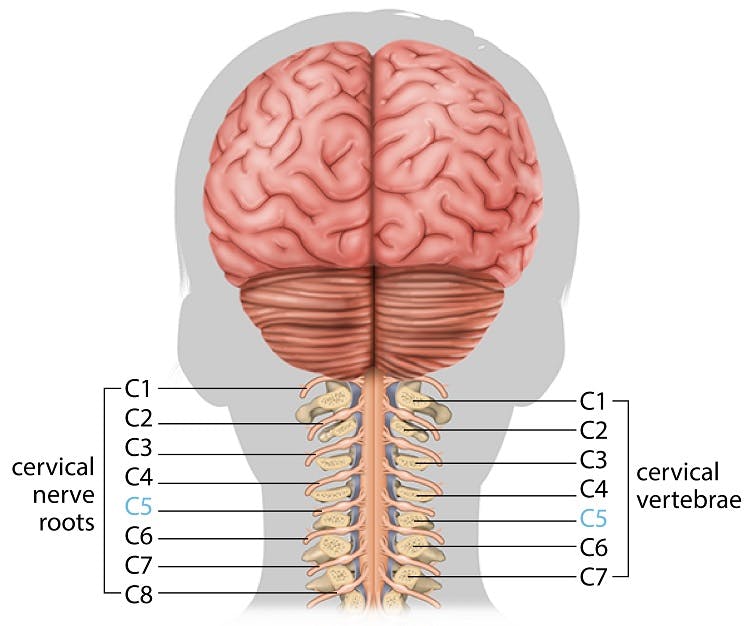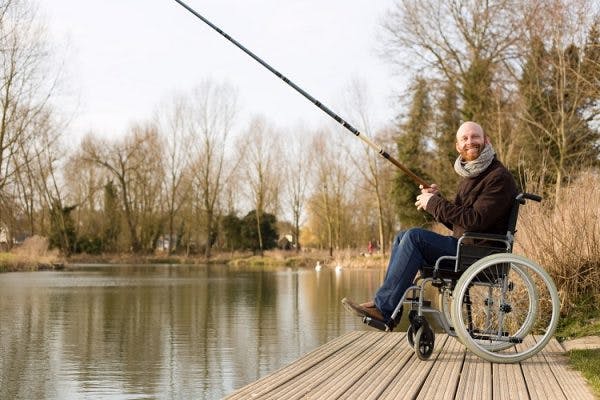A C5 spinal cord injury is the second most common level of SCI, accounting for 15% of all spinal cord injuries. Damage to the C5 spinal cord often results in paralysis of both the upper and lower body, otherwise known as quadriplegia. By participating in rehabilitative therapies, individuals can learn to adjust, cope, and manage this type of cervical spinal cord injury.
To help you understand what to expect after a C5 spinal cord injury, this article will cover affected functions, prognosis, and potential complications.
Incomplete vs. Complete C5 Spinal Cord Injury
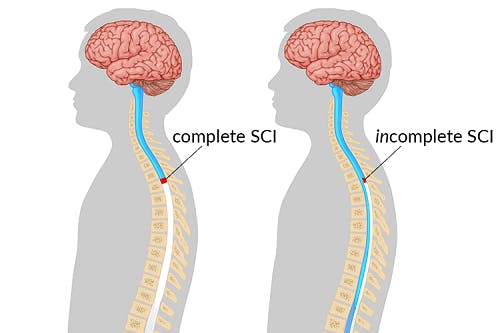
Spinal cord injuries are classified as complete or incomplete. It’s essential to understand the differences between the two because they have different functional implications and prognosis.
Individuals with a C5 complete spinal cord injury will have no sensation or control over movements below their level of injury because no spared neural pathways exist. In other words, there are no pathways to connect messages between the brain and areas below the level of injury.
In contrast, a C5 incomplete spinal cord injury does not transect the entire spinal cord. Simply put, spared neural pathways still exist. As a result, some C5 SCI patients may be able to move and feel areas innervated below their level of injury, although these movements may be very weak.
Spared neural pathways play an essential role in determining rehabilitative outcomes after a C5 SCI because they are capable of neuroplasticity. The less severe a spinal cord injury is, the more spared neural pathways exist, and the better the recovery outlook.
However, neuroplasticity doesn’t work on its own. Individuals must stimulate it by repetitively practicing weakened movements. This will stimulate the spinal cord that there is a demand for that function and promote neurological reintegration and strengthening.
Want 15 pages of SCI recovery exercises in PDF form? Click here to download our free SCI Rehab Exercise ebook now (link opens a pop up for uninterrupted reading)
Up next, we’ll discuss functions affected by C5 SCI.
Functions Affected at the C5 Level of Injury
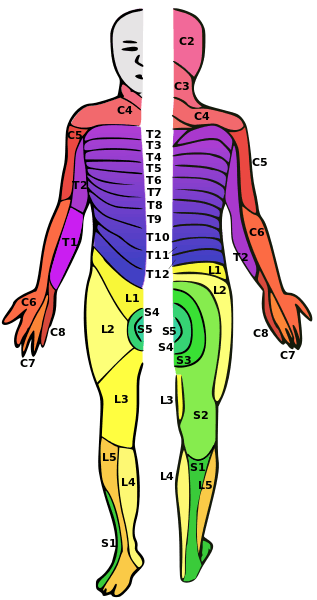
Each level of the spinal cord connects to, or innervates, a specific area of skin for sensation and set of muscles for movement. An individual’s neurological level of injury is determined by identifying the lowest area of the spinal cord where normal sensory and motor functions are still present.
According to the International Standards for Neurological Classification, an assessment of C5 sensory functions is made at the outer area of the upper limbs. Physicians will test for sensation at the lateral side of the elbow crease (antecubital fossa).
A person with a C5 SCI will still have use of the deltoid and bicep muscles. In other words, they will be able to raise their arms up and bend their elbows (to some degree, although these movements may be weak). However, they will most likely have severe weakness or total paralysis of the wrists, hands, trunk, and legs.
The C5 nerves also help innervate a portion of the diaphragm. We will explore this topic further later in the article.
Fortunately, functions at and above the level of injury remain unaffected. As a result, C5 spinal cord injury patients have normal head and neck control. They are also able to raise their shoulders, and flex their elbows. They should also have uninterrupted sensation around the head, neck, shoulders, upper back, collarbones, and anterior side of the uppers.
In the following section, we’ll discuss the prognosis of a C5 spinal cord injury.
What to Expect After a C5 Spinal Cord Injury
As you’ve just learned, functional outcomes of a C5 spinal cord injury are a function of the injury severity. Below, we’ll discuss 7 possible outcomes of C5 spinal cord injuries:
1. Increased Dependence

Because spinal cord injury affects functions innervated below the level of injury, most individuals with C5 injuries may not be able to use their hands or wrists. With such limited mobility, individuals will likely need assistance with everyday tasks.
A caregiver can help C5 SCI patients with activities of daily living. This includes activities like transferring (moving from one surface to another), grooming, toileting, bathing, dressing, and eating. With the right training and use of adaptive equipment, many C5 spinal cord injury patients learn how to adapt and improve self-care.
This study demonstrated that with intense rehabilitation, complete C5 spinal cord injury patients made significant improvements in self-care skills and mobility tasks, although many still required some degree of assistance with these functions.
2. Spinal Shock
After a C5 spinal cord injury, people often lose reflexes and experience flaccid muscle tone below the injury due to spinal shock—a temporary condition.
Right after the injury, the body triggers an inflammatory response to protect the spinal cord. This sets off harsh chemical reactions that can kill cells, cause swelling, and reduce blood flow.
Since blood carries oxygen and nutrients, reduced flow—sometimes by up to 80%—can worsen damage and cause a loss of reflexes and muscle tone.
As the swelling goes down and blood flow improves, some functions may slowly return.
Spinal shock can last from a few days to three months. When it resolves, many are surprised to find their injury isn’t as severe as they first thought.
3. Spasticity
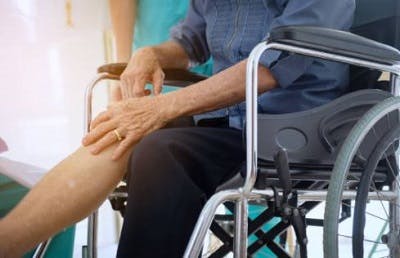
Spasticity describes involuntary muscle contractions that can cause stiffness, spasms, and excess strain on the musculoskeletal system. The muscles remain contracted because they’re not receiving signals from the brain to relax.
However, spasticity is not always a bad thing. A little bit of spasticity can prove beneficial following a spinal cord injury and help promote independence.
For example, spasticity can cause otherwise paralyzed areas of the body to move. Although these movements are involuntary, they can help maintain muscle mass, promote circulation, and stimulate the spinal cord. Likewise, spasticity in the legs and arms can help individuals dress and stand up.
Being able to feel or move your body parts below your level of injury means that neural pathways still exist and are generally a good sign of recovery.
4. Bladder and Bowel Dysfunction
Bladder and bowel dysfunction are extremely common in SCI patients. This is because nerve roots that innervate the bladder and bowel muscles are located at the tail of the spinal cord.
C5 spinal cord injury patients will typically experience high tone in their bladder and bowel muscles, which can reduce capacity and increase pressure. Additionally, these individuals will not receive the message to their brain that their bladder or bowels are full. For this reason, these patients will need to engage in “bowel and bladder programs”. This involves different ways of removing urine and stool before accidents occur.
Complications of bladder and bowel dysfunction include urinary retention, kidney damage, infection, and constipation.
5. Respiratory Complications

The C3-C5 peripheral nerves innervate the diaphragm, a muscle that is essential to breathe. Generally, C5 spinal cord injury patients will not need the assistance of a ventilator. However, they may experience weakness in breathing due to paralysis of the intercostal muscles. C5 SCI patients who are ventilator-dependent often wean off it by the time they leave the hospital.
Common respiratory complications experienced by C5 spinal cord injury patients include:
- Respiratory failure
- Pneumonia
- Pulmonary embolism
- Sleep apnea
- Atelectasis
6. Autonomic Dysreflexia
C5 spinal cord injury patients are at risk of experiencing autonomic dysreflexia. A sudden spike in blood pressure primarily characterizes autonomic dysreflexia when areas below the level of injury encounter a noxious stimulus.
Because of the SCI, your brain is not able to send the message to your body about how to eliminate the noxious stimulus, sending your autonomic nervous system into this reflexive state. As a result, individuals experiencing autonomic dysreflexia may also experience feelings of panic, sweating/flushness, tightness in the chest, pounding headache, and/or nausea.
Normally, the brain sends signals throughout the body to relax the blood vessels. However, after an SCI, brain signals may be unable to reach areas below one’s level of injury. Autonomic dysreflexia can be considered a medical emergency – if you are experiencing the symptoms above, here’s what to do:
- Sit up immediately if you are laying down (this will help to lower your blood pressure back down)
- Look for the cause of the noxious stimulus (could be a full bladder, full bowels, something pressing on/irritating your skin, etc.)
- Remove the irritating stimulus immediately (performing bowel or bladder program, removing whatever is irritating your skin, etc.)
- Once the stimulus is removed you should experience relief. If you don’t, go to the ER immediately.
Because of the potential severity of autonomic dysreflexia, it is very important to have your therapists educate you on the topic when you are in inpatient rehabilitation.
7. Changes in Body Composition
Limited ambulation after C5 spinal cord injury makes it challenging for individuals to be physically active. The human body is extremely adaptive and when you don’t use your muscles and bones, they shrink to conserve energy.
Many spinal cord injury patients initially lose a substantial amount of weight due to loss of bone density and muscle mass. However, many may also gain weight because they continue to consume the same amount of food as they did when they were more physically active. As a result, C5 spinal cord injury patients can experience significant changes in body composition.
Up next, we’ll discuss how to manage complications of C5 spinal cord injuries and improve mobility.
C5 Spinal Cord Injury Rehabilitation
Every C5 spinal cord injury is different, so a personalized rehabilitation plan that addresses each individual’s unique needs is essential.
Management interventions for C5 spinal cord injuries include:
- Rehabilitation therapy typically consists of physical and occupational therapy, which both work towards optimizing mobility. PT focuses on exercise therapy while OT modifies activities of daily living to restore patients’ functions. With the appropriate rehabilitative intervention, many C5 spinal cord injury patients learn how to adapt and improve self-care. If your breathing is weakened due to a C5 SCI, you may initially work with a speech therapist to improve breath support.
- Orthotics are wearable devices that promote correct musculoskeletal alignment and form after C5 SCI. They can also help prevent spastic muscles from further contracting by holding the limb in place.
- Adaptive devices are intended to help spinal cord injury patients with restricted mobility perform everyday activities more independently.
- Medications will vary depending on your complications and can help minimize pain, reduce muscle contractions, and improve mental health status.
- Surgery is typically performed immediately after SCI to stabilize the spine and minimize damage. In cases of severe injury where spasticity limits movement, surgery may also be recommended.
- Catheterization is commonly utilized when individuals cannot control their bladder muscles. It will help avoid accidents and prevent complications like urinary retention and kidney damage.
- Bowel programs can help individuals better schedule and keep track of their bowel movements.
- Breathing and coughing exercises will help C5 spinal cord injury patients increase their lung capacity and prevent the buildup of secretions.
- Diet modifications will help prevent excess weight gain, promote bowel and bladder movements, and fuel the body for ideal recovery.
C5 SCI patients should also practice being mindful of their surroundings. Due to impaired sensation, individuals may not be able to sense that what they are touching is too hot or sharp.
Likewise, regular skin examinations are crucial to identify signs of pressure sores or other irritations early and prevent them from worsening.
Understanding C5 Spinal Cord Injury: Key Points
An injury to the C5 spinal cord generally affects movement and sensation below the upper arms. However, depending on the severity of your SCI, you may be able to move and feel areas innervated below your level of injury.
Every C5 spinal cord injury is unique and factors like rehabilitation intensity, motivation, and the occurrence of secondary complications can significantly impact the prognosis.
Hopefully, this article helped you understand that there is hope for recovery after C5 spinal cord injury and that participation in rehabilitation programs is essential to learn how to adapt and maximize your mobility. Good luck!

